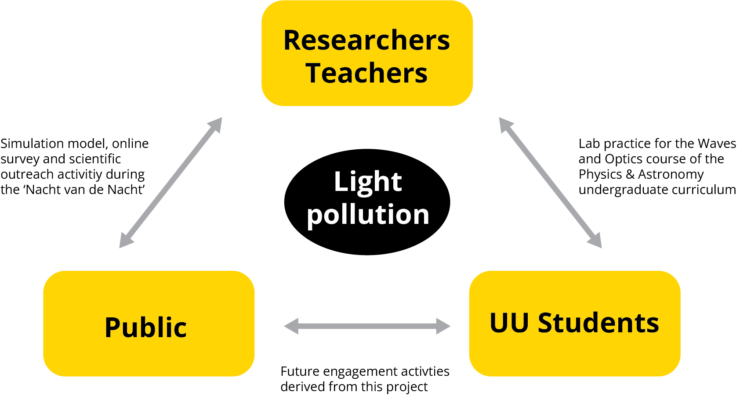Turn on the stars
Light pollution is the central theme within the project ‘Turn on the Stars’. An interdisciplinary team designed educational activities, both for the general public and university students, to create awareness about the negative effects of light pollution on the biodiversity and scientific curiosity. With help from the Community Engaged Learning (CEL) program a scientific outreach activity and lab practice were developed in 2021.
Background
Excessive and misdirected lighting has resulted in polluted night skies with unexpected and unprecedented effects on flora, fauna, and human health. Today, more than 80% of the world population lives under light-polluted skies, and although the Milky Way should be visible to the naked eye, in approximately 43% of the Dutch territory this is no longer possible (Falchi et al., 2016). The loss of visibility of the night sky undermines efforts to encourage scientific curiosity, especially in the younger generations, since astronomy can introduce youngsters to the scientific method and science literacy. Therefore it’s important to raise awareness about this societal issue.
Description and goals
The goal of this project is to develop educational activities which raise awareness about light pollution and promote the development of possible solutions. These activities were designed within a three-way learning and working framework among university students, researchers/teachers, and the public, which can be found in the figure below.

Figure 1. Learning and working framework for awareness about light pollution
These activities were developed by an interdisciplinary team within Utrecht University. Funding from the Community Engaged Learning program helped developing these activities.
Results
The following activities were carried out in the second half of 2021:
During the ‘Nacht van de Nacht’ two information leaflets were shared with the visitors, one for adults and one for children, with more information about the effects and solutions for light pollution. For the children’s leaflet, educational games about light pollution were included. The adult’s version included a QR code for an online survey to explore the perception of the problem in the community. However, the response was not adequate. Therefore other spaces should be sought to disseminate the survey in the future.
New experiments were added the existing ‘POL1-Polarisation of light’ lab practice. The objective of this lab practice is for students to recognize the polarisation of light as a type of light pollution and its ecological effects. The team plans to further develop and pilot this activity in 2022, for which they are seeking funds within UU to support a teaching/lab assistant.
Further reading
- Final report for the CEL program (pdf download)
- Model about light pollution (video description)
- Children’ Leaflet
- Adult Leaflet
- Light pollution survey
References
- Falchi F, Cinzano P, Duriscoe D, Kyba CCM, Elvidge CD, Baugh K, et al. The new world atlas of artificial night sky brightness. Sci Adv. 2016;2(6):1–26.
